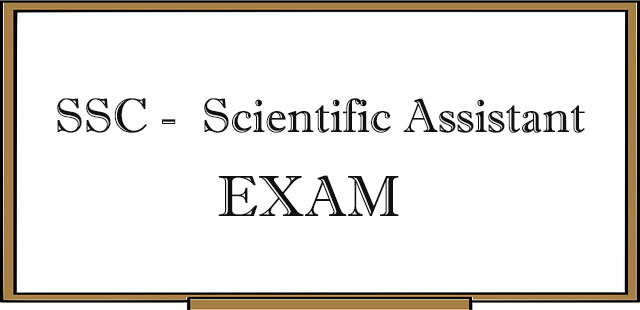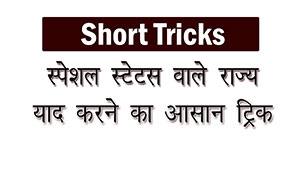-
SSC Scientific Assistant Exam Pattern, Syllabus and Eligibility
Updated : 04-Nov-2017
The Staff Selection Commission or commonly known as SSC Combined Graduate Level (CGL) examinations are those which are held to recruit the candidates to various posts in the Central Government and its various departments. This exam is an all over India competitive exam and anyone who matches the eligibility can appear for this exam. The recruit can get either get a gazetted or a non- gazzeted post
Eligibility of Scientific Assistant Exam
As the notification for SSC scientific assistant is out on the official web portal of SSC, the Educational Qualification and Age Limit for applying for the exam are:
Educational Qualification:
- Candidates should have passed 12th standard with Physics & Math as Core Subjects
- Minimum 60% in Bachelor’s of Science with Physics as one of the subjects
through a recognized board - 3 Year of Diploma course in Electronics & Telecommunication Engineering
- The qualifying Degree or Diploma must be of 3 years duration after 12th board examination.
- Experience Requirements:
- No basic job experience required for a job profile in SSC
- Age Limit (as on 01/08/2017):
Upper age limit – 30 Years
lower age limit – 18 Years- Age Relaxation:
- SC/ST (schedule caste/ schedule tribe) – 5 Years
- OBC (other backward classes – 3 Years
- PH (physical handicapped)– 10 Years
- Ex-Servicemen – 3 Years
Pattern of Scientific Assistant Exam
The recent updates made by SSC about the SSC scientific assistant exam pattern are:
- Part 2 of SSC Scientific Assistant will have three optional subjects:
- Physics
- Computer Science and Information Technology
- Electronics and Telecommunications.
- Candidates will have the option to choose any 1 of the above 3 question papers in Part 2.
Aspirants will be selected through a selection procedure which will consist of an online Computer Based Test. This Test has 2 sections namely Part 1 & Part 2. In Part 1 question will be from General Intelligence level whereas Part 2 questions will be from specific subject related knowledge. Mentioned below is the detailed exam pattern for SSC Scientific Assistant Exam:
Paper
Paper Name
No of
QsTime
Part I
General Intelligence
& Reasoning25
120
MinQuantitative
Aptitude25
General
Awareness25
English language
& Comprehension25
Part II
Physics,
Computer Science
& IT, Electronics &
Telecommunication
Engineering100
The selection of candidates will be based on the marks scored in the Computer Based Test. Based on the marks the State Selection Commission will prepare a merit list of selected candidates .In cases of ties, they will be resolved by applying following methods given below:
- Total marks of Part 1 & Part 2 combined in the Computer based Exam
- Marks obtained in Part 2 of the Computer Based Exam
- Marks obtained in Part 1 of the Computer Based Exam
- Date of birth with preference to older candidates
- Through alphabetical order of the first name of the aspirant as entered in the application form
SYLLABUS
Syllabus for part 1 given below:
A. General Intelligence & Reasoning section
The topics that will include in this section are as follows:
- Analogies,
- Similarities,
- Differences,
- Space visualization,
- Problem Solving
- Analysis,
- Judgment
- Decision making,
- Visual memory,
- Discrimination,
- Observation,
- Relationship Concepts
- Arithmetical Reasoning,
- Verbal and Figure Classification
- Arithmetical number Series etc.
B. Quantitative Aptitude section
- Whole Numbers,
- Decimals
- Fractions and Relationships between numbers,
- Percentage,
- Ratio & Proportion,
- Square roots,
- Averages,
- Interest,
- Profit and Loss,
- Discount,
- Partnership Business,
- Mixture and Allegation,
- Time and Distance,
- Time & Work,
- Basic Algebraic Identities of School Algebra & Elementary Surds,
- Graphs of Linear Equations,
- Triangle and its various Kinds of centers,
- Congruence and similarity of triangles,
- Bar diagram & Pie chart
Some other important topics are mentioned below Circle and its chords, tangents, angles subtended by chords of a circle, common tangents to two or more circles, Triangle, Quadrilaterals, Regular Polygons, Circle, Right Prism with bases, Right Circular Cone with bases, Right Circular Cylinder with bases, Sphere, Hemispheres, Rectangular Parallelepiped, Regular Right Pyramid with triangular or square base, Trigonometric ratio, Degree and Radian Measures, Standard Identities, Complementary angle, Heights and Distances, vectors and scalars, Histogram, Frequency polygon, etc.
C. English Language & Comprehension section
- English Grammar,
- Vocabulary,
- Spellings,
- Synonyms and Antonyms,
- Comprehension,
- Correct and Incorrect usages
D. General Awareness section
- General Physical, Geographical, Topographical, Economic and Climatic features of India.
- Current Events.
- Matters of everyday observation learning can be increased by reading articles and experience on Scientific Aspects and Reasoning.
- Basic topics of Mathematics, Chemistry, and Physics.
- History of India and its Cultural Heritage and the Freedom Movement
- The Salient Feature of the Constitution of India.
- Economic and Social aspect of our country and its people.
Syllabus for part 2 of Scientific Assistant Exam
A. Physics section
- Mechanics
- Thermal Physics, Radiation & Sound.
- Wave and Oscillations
- Optics
- Electricity and magnetism
- Atomic structure
- Electronics
B. Computer Science & Information Technology section
- Computer
- Operating systems
- Virtual Memory
- File System
- I/O System
- Assemblers
- Fundamentals of programming: UNIX Programming, Programming in FORTRAN, C, Object Oriented Programming in C++, programming in Java, Basics of compilers.
- Database Management Systems
- Internet Technology
- Fundamentals of Geographical Information System (GIS)
C. Electronics section
- Conductors,
- Semi-conductors
- Insulators,
- Magnetic, Passive components,
- Characteristics of Resistors, Capacitors and inductors
- Zener diode and applications
- Bipolar Junction Transistors, Field Effect Transistor
- Biasing and stability, Emitter following and its applications which is based on Negatives feedback-Transistor as a switch,
- Multistage Amplifiers, Feedback, Oscillators, Multivibrators, Voltage regulation, Power amplifiers.
- Introduction to Network Theorems
- Digital electronics
- Telecommunication
- Basic antenna principle directive gain
- directivity, radiation pattern, broad-side and end-fire array,
- Yagi antenna, Ground wave propagation, space waves, ionosphere propagation and electromagnetic frequency
- Modulation, types of modulation
- Amplitude Modulation, Modulation index, Power relation in AM, Generation and Demodulation of Amplitude Modulation.
- Single Side Band
- Frequency Modulation
- Pulse Modulation
- Radio Sampling Theorem, PAM, PWM, PPM, pulse code modulation, Quantization noise, commanding, PCM system, differential PCM and Delta modulation.
- Multiplexing in FDM/TDM.
- Introduction of digital Communication in PSK, ASK, FSK, introduction to fiber optics system and Propagation of light in optical fiber and ray model.
- Propagation of signals at HF, VHF and UHF and microwave frequency and satellite communications














